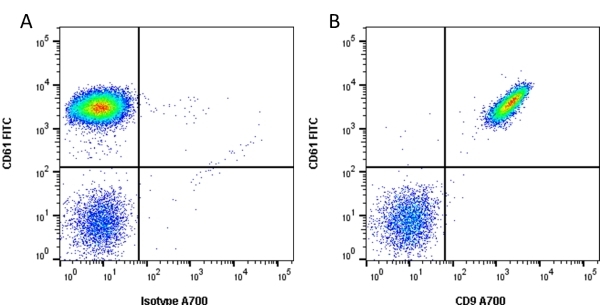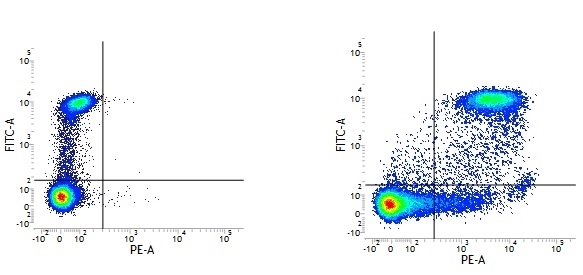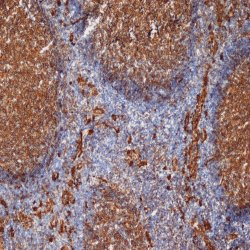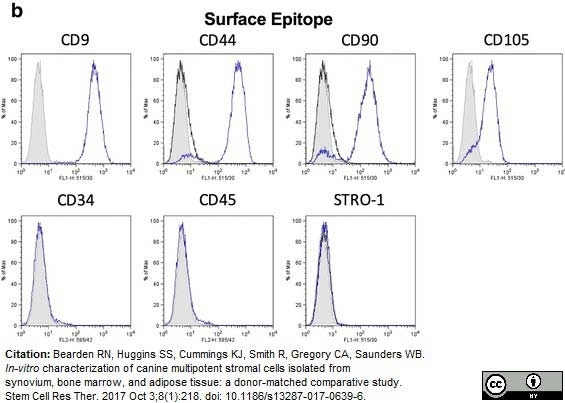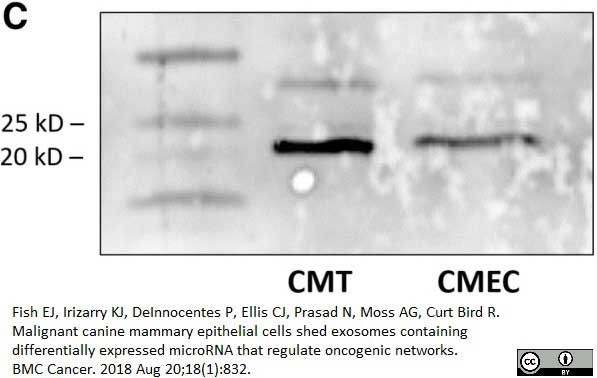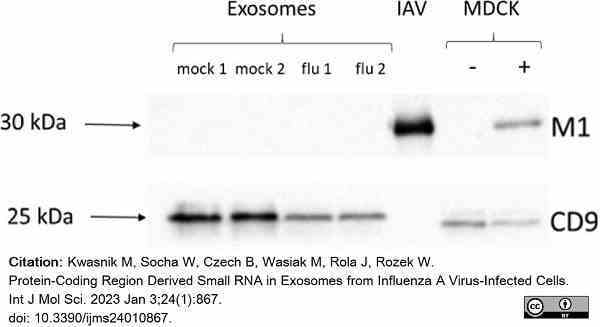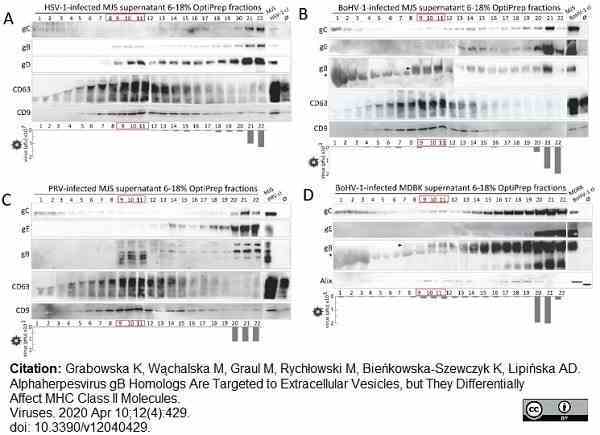CD9 antibody | MM2/57








Mouse anti Human CD9:FITC
- Product Type
- Monoclonal Antibody
- Clone
- MM2/57
- Isotype
- IgG2b
- Specificity
- CD9
| Mouse anti Human CD9 antibody, clone MM2/57 recognizes human leukocyte antigen MIC3 also known as MRP-1 or CD9. CD9 is a 228 amino acid multi pass membrane glycoprotein belonging to the tetraspanin family with a molecular weight of ~24 kDa expressed by platelets, monocytes, some lymphocytes and endothelial cells. Mouse anti Human CD9 antibody, clone MM2/57 recognizes a conserved epitope on CD9 present on a wide range of mammalian species. |
- Target Species
- Human
- Species Cross-Reactivity
-
Target Species Cross Reactivity Cat Rhesus Monkey Bovine Dog Rabbit Horse Pig Mustelid Expected from Sequence Mink Llama Ferret - N.B. Antibody reactivity and working conditions may vary between species.
- Product Form
- Purified IgG conjugated to Fluorescein Isothiocyanate Isomer 1 (FITC) - liquid
- Preparation
- Purified IgG prepared by affinity chromatography on Protein A from tissue culture supernatant.
- Buffer Solution
- Phosphate buffered saline
- Preservative Stabilisers
0.09% Sodium Azide 1% Bovine Serum Albumin - Immunogen
- Human platelet membranes
- Approx. Protein Concentrations
- IgG concentration 0.1 mg/ml
- Fusion Partners
- Spleen cells from immunised BALB/c mice were fused with cells from the SP2/0 mouse myeloma line
- Max Ex/Em
-
Fluorophore Excitation Max (nm) Emission Max (nm) FITC 490 525 - Regulatory
- For research purposes only
- Guarantee
- 12 months from date of despatch
Avoid repeated freezing and thawing as this may denature the antibody. Storage in frost-free freezers is not recommended. This product is photosensitive and should be protected from light.
| Application Name | Verified | Min Dilution | Max Dilution |
|---|---|---|---|
| Flow Cytometry | Neat |
- Flow Cytometry
- Use 10ul of the suggested working dilution to label 106 cells in 100ul.
| Description | Product Code | Applications | Pack Size | List Price | Your Price | Quantity | |
|---|---|---|---|---|---|---|---|
| Mouse IgG2b Negative Control:FITC | MCA691F | F | 100 Tests |
|
Log in | ||
| List Price | Your Price | ||||||
|
|
Log in | ||||||
| Description | Mouse IgG2b Negative Control:FITC | ||||||
| Description | Product Code | Applications | Pack Size | List Price | Your Price | Quantity | |
|---|---|---|---|---|---|---|---|
| Human Seroblock | BUF070A | F | 50 Test | Log in | |||
| List Price | Your Price | ||||||
| Log in | |||||||
| Description | Human Seroblock | ||||||
| Human Seroblock | BUF070B | F | 200 Test | Log in | |||
| List Price | Your Price | ||||||
| Log in | |||||||
| Description | Human Seroblock | ||||||
References for CD9 antibody
-
Ed Knapp W. et al. (1989) Leucocyte Typing IV
Oxford University Press. -
Jennings, L. K. et al. (1995) CD9 cluster workshop report: cell surface binding and functional analysis.
In S.F. Sclossman. et al. Editors. 1995. Leucocyte Typing V. White Cell Differentiation Antigens. Oxford University Press, New York, NY. 1249-1251. -
Löffler, S. et al. (1997) CD9, a tetraspan transmembrane protein, renders cells susceptible to canine distemper virus.
J Virol. 71: 42-9. -
Brodersen, R. et al. (1998) Analysis of the immunological cross reactivities of 213 well characterized monoclonal antibodies with specificities against various leucocyte surface antigens of human and 11 animal species.
Vet Immunol Immunopathol. 64 (1): 1-13. -
Ferrer, M. et al. (1998) Pattern of expression of tetraspanin antigen genes in Burkitt lymphoma cell lines.
Clin Exp Immunol. 113: 346-52. -
Kao, Y.R. et al. (2003) Tumor-associated antigen L6 and the invasion of human lung cancer cells.
Clin Cancer Res. 9: 2807-16. -
Aasted, B. et al. (2007) Reactivity of monoclonal antibodies to human CD antigens with cells from mink.
Vet Immunol Immunopathol. 119: 27-37. -
Davis, W.C. et al. (2007) Use of flow cytometry to identify monoclonal antibodies that recognize conserved epitopes on orthologous leukocyte differentiation antigens in goats, llamas, and rabbits.
Vet Immunol Immunopathol. 119: 123-30.
View The Latest Product References
-
Meister, R.K. et al. (2007) Progress in the discovery and definition of monoclonal antibodies for use in feline research.
Vet Immunol Immunopathol. 119: 38-46. -
Martel, C.J. & Aasted, B. (2009) Characterization of antibodies against ferret immunoglobulins, cytokines and CD markers.
Vet Immunol Immunopathol. 132:109-15. -
Müller, T. et al. (2009) A novel embryonic stem cell line derived from the common marmoset monkey (Callithrix jacchus) exhibiting germ cell-like characteristics.
Hum Reprod. 24: 1359-72. -
Kubota, H. et al. (2011) Glial cell line-derived neurotrophic factor and endothelial cells promote self-renewal of rabbit germ cells with spermatogonial stem cell properties.
FASEB J. 25 (8): 2604-14. -
Hogue, I.B. et al. (2011) Gag induces the coalescence of clustered lipid rafts and tetraspanin-enriched microdomains at HIV-1 assembly sites on the plasma membrane.
J Virol. 85 (19): 9749-66. -
Viswanathan, K. et al. (2017) Quantitative membrane proteomics reveals a role for tetraspanin enriched microdomains during entry of human cytomegalovirus.
PLoS One. 12 (11): e0187899. -
Bearden, R.N. et al. (2017) In-vitro characterization of canine multipotent stromal cells isolated from synovium, bone marrow, and adipose tissue: a donor-matched comparative study.
Stem Cell Res Ther. 8 (1): 218. -
Jackson, C.E. et al. (2017) Effects of Inhibiting VPS4 Support a General Role for ESCRTs in Extracellular Vesicle Biogenesis.
Biophys J. 113 (6): 1342-1352. -
Fish, E.J. et al. (2018) Malignant canine mammary epithelial cells shed exosomes containing differentially expressed microRNA that regulate oncogenic networks.
BMC Cancer. 18 (1): 832. -
Wąchalska, M. et al. (2020) Palmitoylated mNeonGreen Protein as a Tool for Visualization and Uptake Studies of Extracellular Vesicles.
Membranes (Basel). 10 (12): 373. -
Fu, T.S. et al. (2023) Biomimetic vascularized adipose-derived mesenchymal stem cells bone-periosteum graft enhances angiogenesis and osteogenesis in a male rabbit spine fusion model.
Bone Joint Res. 12 (12): 722-33. -
Kwasnik, M. et al. (2023) Protein-Coding Region Derived Small RNA in Exosomes from Influenza A Virus-Infected Cells.
Int J Mol Sci. 24 (1): 867. -
Grabowska, K. et al. (2020) Alphaherpesvirus gB Homologs Are Targeted to Extracellular Vesicles, but They Differentially Affect MHC Class II Molecules.
Viruses. 12 (4): 429.
- Synonyms
- MRP-1
- RRID
- AB_321492
- UniProt
- P21926
- Entrez Gene
- CD9
- GO Terms
- GO:0005515 protein binding
- GO:0002576 platelet degranulation
- GO:0007155 cell adhesion
- GO:0005887 integral to plasma membrane
- GO:0006928 cellular component movement
- GO:0007342 fusion of sperm to egg plasma membrane
- GO:0030168 platelet activation
- GO:0030913 paranodal junction assembly
- GO:0031092 platelet alpha granule membrane
- View More GO Terms
MCA469FT
MCA469F
If you cannot find the batch/lot you are looking for please contact our technical support team for assistance.
Please Note: All Products are "FOR RESEARCH PURPOSES ONLY"
View all Anti-Human ProductsAlways be the first to know.
When we launch new products and resources to help you achieve more in the lab.
Yes, sign me up